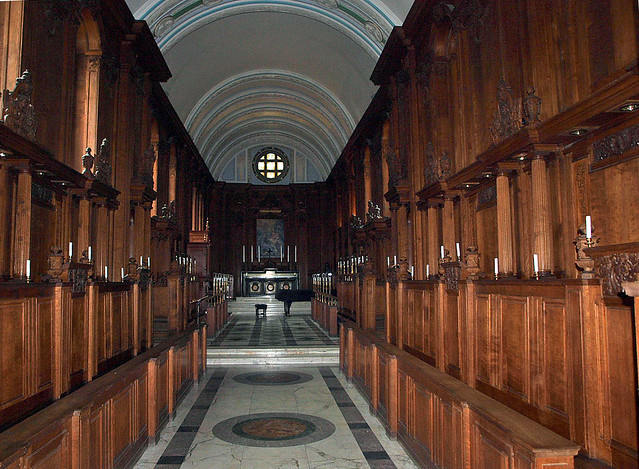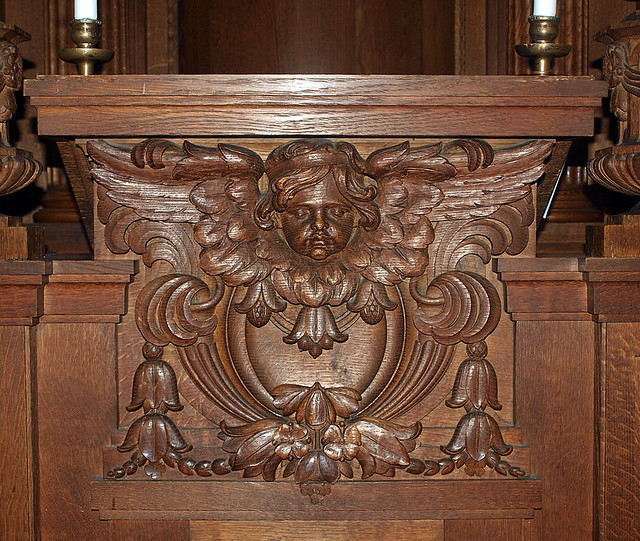To return now through Hall Court into Second Court, the CHAPEL of 1600 was replaced by one of Essex’s design in 1776-82. It was again rebuilt and this time considerably lengthened towards E in 1912. The architect of the work was T. H. Lyon. He has created a remarkably fine piece of ecclesiastical architecture in a free Neo-Wren style. The room is 90 ft long. The steps across mark the length of the former chapel. It is barrel-vaulted, and the walls are adorned with elaborate woodwork designed with gusto and imagination. It is carved by Reed of Exeter. Above the altar is a large PAINTING by the Venetian G. B. Pittoni, purchased in 1783. The beautiful CANDLESTICKS are dated 1740. To the r. of the altar space is a low side chapel with a gallery over, both opened to the chapel by arches. The STAINED GLASS in the chapel is by Tower.
Founded by a bequest of Lady Frances Sidney, aunt of Sir Philip and widow of the Earl of Sussex, it stands on the site of a suppressed house of Franciscan Friars. Its two small courts are in Sidney Street in the busy heart of the town, their buildings embattled and gabled, and the gateway like a tower with oriel windows and archways leading to both courts. The Master's garden behind the courts has lawns and trees and flowers; the garden close by has a splendid chestnut tree with branches making a circle 80 yards round, above a white and gold carpet of snowdrops and aconites. North of the Hall Court is a court of brick and stone built in 1891 from designs by Mr J. L. Pearson, charming with its richly carved bay windows, curved gables, and arcaded cloister.
The first buildings set up were those of the Hall Court at the end of the 16th century. A few years later the refectory of the Franciscans, which had survived the general destruction, was fitted up as a chapel and a room was built over it for a library. The south range of the Chapel Court was added about 1628.
In the middle of the 18th century the hall (about 60 feet long) was given its rich ceiling, its wall-panelling, and the screen, which has fluted columns supporting the gallery. Over the high table is a fine portrait of the founder in a rich fur-trimmed gown with a ruff, a tiny dog jumping up at her feet. Other portraits here are of Bishop James Montagu, the first Master, wearing a cap; Sir William Montagu, a judge, in fashionable dress with much lace and embroidery; Lord Montagu in a red and white robe. Linking a man greater than these with the college is the curtained portrait of Oliver Cromwell, who came as a fellow commoner in the year Shakespeare died, and went down the following year on his own father’s death.
The portrait is a magnificent presentation of the man as history tells of him, and of what we believe him to have been. The big forehead, the sagacious brow, the observant eyes, the rugged features, the stern mouth and slightly underhung jaw—all are in this portrait, which has a curious history. In 1766 Dr William Elliston, Master of the College, received a letter informing him that “an Englishman, an assertor of Liberty, Citizen of the World, is desirous of having the honour to present an original portrait in crayons of the head of O. Cromwell, Protector, drawn by Cooper, to Sidney Sussex College, in Cambridge.” The writer requested that on the arrival of the picture “the favour of a line might be written to Pierce Delver, at Mr Shove’s, Bookbinder, in Maiden Lane, Covent Garden, London.” The portrait arrived, and the letter of acknowledgment was written, but the donor did not make himself known; and it was not until 1780 that the identity of Pierce Delver with Thomas Holles was discovered.
This portrait has sometimes been attributed to Peter Lely and not to Samuel Cooper, partly because of the anecdote that Cromwell sat to Lely and while sitting said, “Mr Lely, I desire you would use all your skill to paint my picture truly like me, and not to flatter me at all; but remark all these roughnesses, pimples, warts, and everything you see, otherwise I never will pay a farthing for it.” But we do not recognise the style as that of Lely. It is much more like Samuel Cooper, to whom Cromwell certainly did sit; and this superb piece of portraiture has a curious resemblance in strength to that of Charles the Second, painted when he was an elderly man, now hanging in the Fitzwilliam Museum.
The chapel, with a big bell in the stepped gable facing the street, was rebuilt in the 18th century, and in our own time has been transformed into a dignified and stately place more than double its old length. Its floor, of different levels, is paved with coloured marbles; and the woodwork with which it is adorned makes it perhaps the richest in any Cambridge college. The panelling covering the walls to the coved ceiling has a cornice carved with flowers and cherubs. There are carved benches and stalls; two beautiful stalls with domed canopies are on the screen at the west end, which has a lovely coloured figure of St George in armour. The oak recesses with seats on the north side have arches carved with flowers, cherubs, and birds. On the south side, leading to a dainty little lady chapel with a white vaulted ceiling, is a fine oak arcade with a richly panelled gallery where scenes of Bible story are carved in roundels. Behind the high altar is Francesco Pittoni’s lovely painting of the Flight into Egypt, with cherubs above Joseph and Mary and the Holy Child. In a recess is an oak figure of St Francis as a monk, birds about him.
The first buildings set up were those of the Hall Court at the end of the 16th century. A few years later the refectory of the Franciscans, which had survived the general destruction, was fitted up as a chapel and a room was built over it for a library. The south range of the Chapel Court was added about 1628.
In the middle of the 18th century the hall (about 60 feet long) was given its rich ceiling, its wall-panelling, and the screen, which has fluted columns supporting the gallery. Over the high table is a fine portrait of the founder in a rich fur-trimmed gown with a ruff, a tiny dog jumping up at her feet. Other portraits here are of Bishop James Montagu, the first Master, wearing a cap; Sir William Montagu, a judge, in fashionable dress with much lace and embroidery; Lord Montagu in a red and white robe. Linking a man greater than these with the college is the curtained portrait of Oliver Cromwell, who came as a fellow commoner in the year Shakespeare died, and went down the following year on his own father’s death.
The portrait is a magnificent presentation of the man as history tells of him, and of what we believe him to have been. The big forehead, the sagacious brow, the observant eyes, the rugged features, the stern mouth and slightly underhung jaw—all are in this portrait, which has a curious history. In 1766 Dr William Elliston, Master of the College, received a letter informing him that “an Englishman, an assertor of Liberty, Citizen of the World, is desirous of having the honour to present an original portrait in crayons of the head of O. Cromwell, Protector, drawn by Cooper, to Sidney Sussex College, in Cambridge.” The writer requested that on the arrival of the picture “the favour of a line might be written to Pierce Delver, at Mr Shove’s, Bookbinder, in Maiden Lane, Covent Garden, London.” The portrait arrived, and the letter of acknowledgment was written, but the donor did not make himself known; and it was not until 1780 that the identity of Pierce Delver with Thomas Holles was discovered.
This portrait has sometimes been attributed to Peter Lely and not to Samuel Cooper, partly because of the anecdote that Cromwell sat to Lely and while sitting said, “Mr Lely, I desire you would use all your skill to paint my picture truly like me, and not to flatter me at all; but remark all these roughnesses, pimples, warts, and everything you see, otherwise I never will pay a farthing for it.” But we do not recognise the style as that of Lely. It is much more like Samuel Cooper, to whom Cromwell certainly did sit; and this superb piece of portraiture has a curious resemblance in strength to that of Charles the Second, painted when he was an elderly man, now hanging in the Fitzwilliam Museum.
The chapel, with a big bell in the stepped gable facing the street, was rebuilt in the 18th century, and in our own time has been transformed into a dignified and stately place more than double its old length. Its floor, of different levels, is paved with coloured marbles; and the woodwork with which it is adorned makes it perhaps the richest in any Cambridge college. The panelling covering the walls to the coved ceiling has a cornice carved with flowers and cherubs. There are carved benches and stalls; two beautiful stalls with domed canopies are on the screen at the west end, which has a lovely coloured figure of St George in armour. The oak recesses with seats on the north side have arches carved with flowers, cherubs, and birds. On the south side, leading to a dainty little lady chapel with a white vaulted ceiling, is a fine oak arcade with a richly panelled gallery where scenes of Bible story are carved in roundels. Behind the high altar is Francesco Pittoni’s lovely painting of the Flight into Egypt, with cherubs above Joseph and Mary and the Holy Child. In a recess is an oak figure of St Francis as a monk, birds about him.



No comments:
Post a Comment